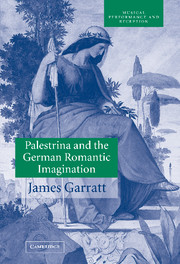Book contents
- Frontmatter
- Contents
- Acknowledgements
- List of abbreviations
- Introduction
- 1 Historicism in nineteenth-century art, aesthetics and culture
- 2 Romanticism and the problem of church music
- 3 The Protestant Palestrina revival
- 4 The Catholic Palestrina revival
- 5 Palestrina in the concert hall
- 6 Interpreting the secondary discourse of nineteenth-century music
- Notes
- Bibliography
- Index
2 - Romanticism and the problem of church music
Published online by Cambridge University Press: 12 October 2009
- Frontmatter
- Contents
- Acknowledgements
- List of abbreviations
- Introduction
- 1 Historicism in nineteenth-century art, aesthetics and culture
- 2 Romanticism and the problem of church music
- 3 The Protestant Palestrina revival
- 4 The Catholic Palestrina revival
- 5 Palestrina in the concert hall
- 6 Interpreting the secondary discourse of nineteenth-century music
- Notes
- Bibliography
- Index
Summary
HOFFMANN AND THE ROMANTIC IDEALIZATION OF PALESTRINA
So far, we have explored the complex strands of historicist thought that encouraged the idealization and emulation of historical styles in general terms. It is now necessary to examine the emergence of the Palestrina revival, establishing how early Romantic commentators on church music engaged with the ideas and tendencies described earlier. E. T. A. Hoffmann's essay ‘Alte und neue Kirchenmusik’ (1814) has been chosen as the framework for this discussion because it provides an exposition of most of the themes central to the Palestrina revival, not because it initiated them. Hoffmann was neither the first nor the most influential German Romantic writer to idealize the music of Palestrina and to agitate for church music reform: the significance of his essay lies primarily in its synthesis of existing ideas on reform and on the revival of old music. But while much of what Hoffmann wrote had been said before (in particular in earlier issues of the AmZ), he was the first author to single out Palestrina for particular attention and to justify his elevation as the paradigm of church music through detailed historical and aesthetic arguments. Moreover, Hoffmann was the first commentator to engage seriously with the question of how modern composers should respond to the Palestrina ideal: his response to this problem, while seemingly fuzzy and impractical, outlines the major issues with which critics and composers were to wrestle throughout the nineteenth century.
- Type
- Chapter
- Information
- Palestrina and the German Romantic ImaginationInterpreting Historicism in Nineteenth-Century Music, pp. 36 - 61Publisher: Cambridge University PressPrint publication year: 2002

